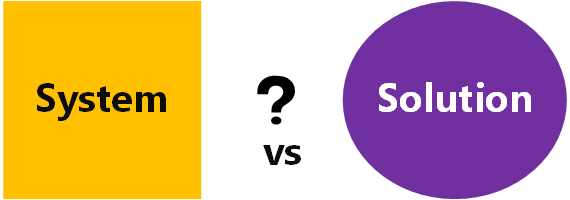Understanding the Key Distinctions Between Systems and Solutions
Written on
Chapter 1: Defining Systems and Solutions
In the world of technology, the term "solution" is frequently used, yet its meaning can be ambiguous. Is a solution synonymous with a system or merely a tool? For instance, can a data pipeline, a new sales dashboard, or machine learning be classified as a solution? The rapid growth of new software offerings and their accompanying marketing can blur the lines between "system" and "solution," leading to misunderstandings.
It's crucial to recognize that "system" and "solution" are not interchangeable. Let's clarify the distinction.
A system refers to an interconnected set of components working together. In the realm of information technology, this typically signifies a software application or a combination of software and hardware designed to fulfill a specific purpose, such as an order management system or a building monitoring system.
What, then, constitutes a solution?
A solution is fundamentally an answer to a specific problem.
We create solutions to effect change, enhance processes, or enable capabilities that were previously unattainable. For example, recycling serves as a solution to the challenge of finite resources. Similarly, a translation engine addresses the demand for swiftly translating extensive text at minimal costs.
In a business context, a solution encompasses both tangible and intangible elements—systems, processes, and mindsets—that collectively foster the resolution of a problem or the fulfillment of a business requirement.
Consider this scenario: a rise in customer complaints regarding a new product. The volume of complaints has become overwhelming, making timely responses difficult.
Would implementing a complaint management system suffice? While this new software could help organize and monitor complaints, it does not inherently resolve the core issue at hand.
To truly tackle the problem, a more comprehensive approach is necessary.
First, conduct a thorough business analysis. Collaborate with stakeholders to identify the underlying causes of product shortcomings. Gather and scrutinize data to diagnose where product defects emerge. Analyze consumer feedback to pinpoint the most pressing complaints.
This analytical process will yield valuable insights into the problem and outline the requirements for an effective solution.
But what could this solution entail?
Until the business analysis is complete, the answer remains unclear. We might uncover issues related to raw materials, storage, or manufacturing processes. Perhaps software errors are leading to incorrect product deliveries, or packaging is inadequate, or logistical shortcomings are present.
Ultimately, a solution will be a composite of all elements necessary to resolve the issue.
This could involve decisions such as:
- Switching to a new supplier
- Updating software
- Modifying business processes
- Retraining employees
- Implementing enhanced quality checks or upgraded monitoring tools
- Revising data collection methods
- Launching a customer outreach initiative to mend reputational harm
In conclusion, a solution transcends a mere system. It may incorporate new systems, modifications to existing ones, or even the phasing out of outdated systems in favor of third-party services.
Solving complex enterprise challenges may necessitate the development of multiple new systems that integrate with the current application landscape, along with the requisite organizational changes to optimize their use.
Solutions are typically delivered by cross-functional teams, encompassing both technological and non-technological elements, process adjustments, documentation, communication strategies, and sometimes even shifts in organizational structure.
Business analysts play a pivotal role, focusing not just on system requirements, but also on capturing the full scope of solution requirements.
Section 1.1: The Importance of Business Analysis
Understanding the problem is the first step to finding the right solution.
Subsection 1.1.1: Analyzing Customer Complaints

Section 1.2: Crafting Effective Solutions
Chapter 2: Key Differences Between Systems and Solutions
This video, titled "System vs Solution: Unveiling the Key Differences in Just 5 Minutes," succinctly explains the distinctions between these two concepts, providing clarity on their unique roles in technology and business.
In the video "System Integrator vs Solutions Architect," viewers gain insights into the specific responsibilities and functions of these roles, further emphasizing the importance of understanding systems and solutions in an enterprise context.